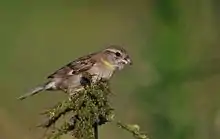Dead Sea sparrow
The Dead Sea sparrow (Passer moabiticus) is a species of bird in the Old World sparrow family Passeridae, with one subspecies breeding in parts of the Middle East and another in western Afghanistan and eastern Iran. The eastern subspecies P. m. yatii is sometimes considered a separate species known as Yate's sparrow.
| Dead Sea sparrow | |
|---|---|
 | |
 | |
| Male (above) and female (below) in south-eastern Turkey | |
| Scientific classification | |
| Kingdom: | Animalia |
| Phylum: | Chordata |
| Class: | Aves |
| Order: | Passeriformes |
| Family: | Passeridae |
| Genus: | Passer |
| Species: | P. moabiticus |
| Binomial name | |
| Passer moabiticus (Tristram, 1864) | |
| Synonyms | |
| |

Description
At 12–13 cm (4.7–5.1 in) long it is one of the smaller species of its family, some 4 cm (1.6 in) shorter than the widespread house sparrow.[2] Like most of its relatives, it is sexually dimorphic with males being more brightly and distinctively marked than females.[3]
The male Dead Sea sparrow has a grey crown, rear neck and cheeks, and a small black bib. It has a pale supercilium shading to buff at the rear, and yellow neck sides. The upperparts are dark-streaked reddish brown, and the underparts are grey-white.
The female looks like a small house sparrow, with a streaked brown back, greyish head and buff-white underparts. She is paler and smaller billed than the house sparrow, and sometimes shows yellow on the neck sides.
The eastern subspecies P. m. yatii is sandier, and the male has a yellow wash to the underparts.
The chirping song resembles those of house and Spanish sparrows, but is softer. The flight call is a high-pitched chi-wit. This species is often silent.
Distribution and habitat
The range of this species is spotty in the Middle East, largely in corridors along the Jordan River and the Euphrates River, ranging from southern Turkey and Cyprus to the southwestern corner of Iran. The subspecies P. m. yatii breeds only in the Sistan region of southwestern Afghanistan and eastern Iran. While the species was initially recorded by scientists breeding only in a restricted range by the Dead Sea, hence the species' name, more populations were discovered further east and it expanded its known range over the second half of the 20th century. The species was first recorded on the island of Cyprus in 1973 and bred a few years later. Though changes to habitat reduced the size of this population soon after it is thought small numbers still breed in Cyprus.[4] This species is migratory or dispersive away from its breeding season. The eastern subspecies winters in western Pakistan, but the regular wintering grounds of the western subspecies are largely unknown. Winter searches for the species near its western breeding range only find scattered flocks. It is possible they disperse widely in winter, as flocks have been found in winter further south and east than where they breed, including in the United Arab Emirates and Saudi Arabia.[4]
Genetic analysis of birds in Israel revealed high connectivity among different populations indicating migration of individuals between these populations. However, despite this gene flow there is latitudinal variation in wing length and body mass, with individuals in the north of Israel having longer wings and being heavier than those in the south suggesting local adaption in accordance with Bergmann's rule.[5]
Behaviour
This species feeds principally on seeds, like other sparrows. It breeds in dry lowlands with some shrubs, including tamarisk, and access to water. It builds a nest in a tree, and four to seven eggs are laid.
References
- BirdLife International (2012). "Passer moabiticus". IUCN Red List of Threatened Species. 2012. Retrieved 26 November 2013.CS1 maint: ref=harv (link)
- Mullarney et al. 1999, pp. 342–343.
- Summers-Smith 1988, p. 181-182.
- Summers-Smith, J. Denis (2009). "Family Passeridae (Old World Sparrows)". In del Hoyo, Josep; Elliott, Andrew; Christie, David (eds.). Handbook of the Birds of the World. Volume 14: Bush-shrikes to Old World Sparrows. Barcelona: Lynx Edicions. ISBN 978-84-96553-50-7.
- Cohen, T.M.; Haran, R.; Dor, R. (2019). "Signals of local adaptation across an environmental gradient among highly connected populations of the Dead Sea Sparrow Passer moabiticus in Israel". Ibis. 161 (3): 619–631. doi:10.1111/ibi.12652.
Works cited
- Clement, Peter; Harris, Alan; Davis, John (1993). Finches and Sparrows: an Identification Guide. Princeton, New Jersey: Princeton University Press. ISBN 0-691-03424-9.
- Mullarney, Killian; Svensson, Lars; Zetterstrom, Dan; Grant, Peter (1999). Collins Bird Guide (1st. ed.). London: HarperCollins. ISBN 978-0-00-219728-1.CS1 maint: ref=harv (link)
- Summers-Smith, J. Denis (1988). The Sparrows. illustrated by Robert Gillmor. Calton, Staffs, England: T. & A. D. Poyser. ISBN 0-85661-048-8.CS1 maint: ref=harv (link)
- Yom-Tov, Yoram; Ar, A (1980). "On the breeding ecology of the Dead Sea sparrow, Passer moabiticus". Israel Journal of Zoology. 29 (4): 171–187.
- Yom-Tov, Yoram (1980). "Intraspecific nest parasitism among dead sea sparrows Passer moabiticus". Ibis. 122 (2): 234–237. doi:10.1111/j.1474-919X.1980.tb02663.x.
- Yom-Tov, Y.; Ar, A.; Mendelssohn, H. (1978). "Incubation Behavior of the Dead Sea Sparrow". Condor. 80 (3): 340–343. doi:10.2307/1368046. JSTOR 1368046.
- Yosef, Reuven; Zduniak, Piotr; Tryjanowski, Piotr (2004). "Age, sex and season related biometrics of the Dead Sea Sparrow Passer moabiticus" (PDF). Ardeola. 51 (2): 297–302.
External links
 Media related to Passer moabiticus at Wikimedia Commons
Media related to Passer moabiticus at Wikimedia Commons- Dead Sea sparrow at the Internet Bird Collection
